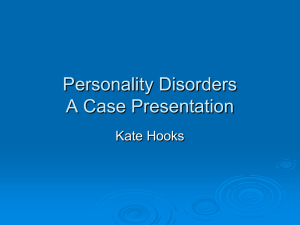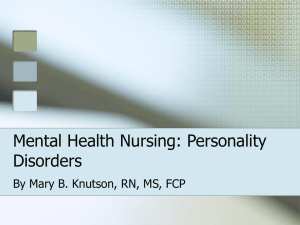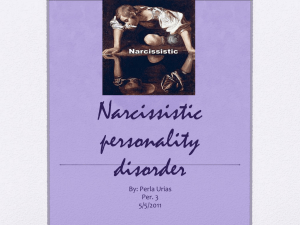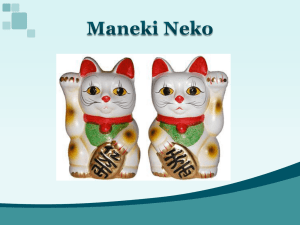Personality major assignment
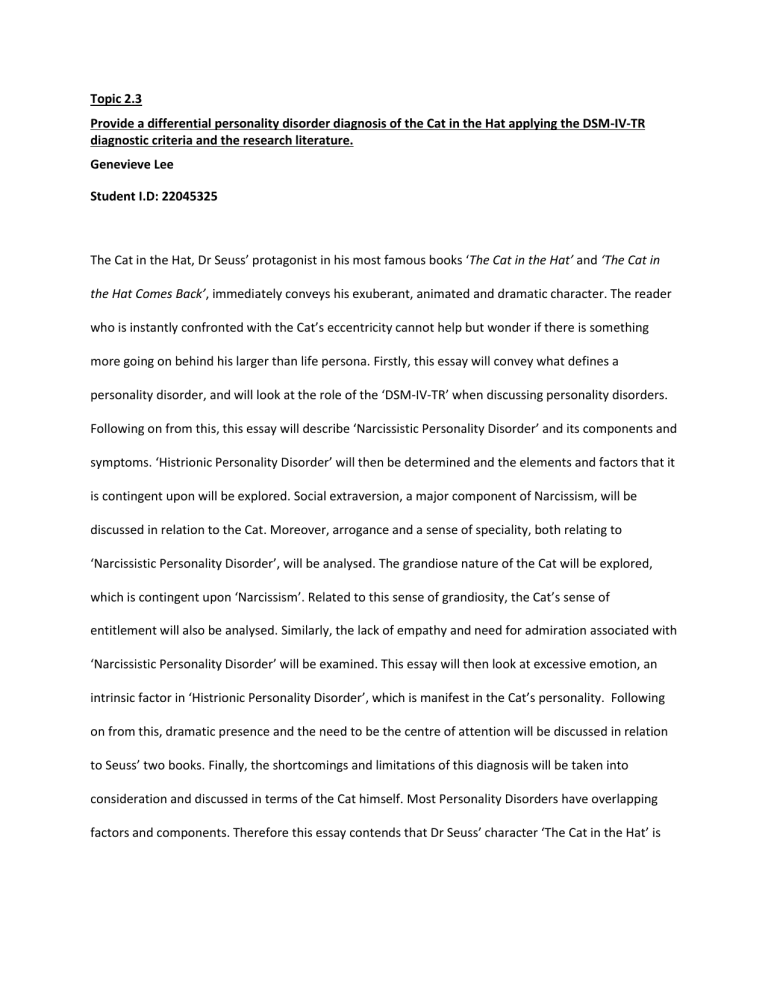
Topic 2.3
Provide a differential personality disorder diagnosis of the Cat in the Hat applying the DSM-IV-TR diagnostic criteria and the research literature.
Genevieve Lee
Student I.D: 22045325
The Cat in the Hat, Dr Seuss’ protagonist in his most famous books ‘The Cat in the Hat’ and ‘The Cat in
the Hat Comes Back’, immediately conveys his exuberant, animated and dramatic character. The reader who is instantly confronted with the Cat’s eccentricity cannot help but wonder if there is something more going on behind his larger than life persona. Firstly, this essay will convey what defines a personality disorder, and will look at the role of the ‘DSM-IV-TR’ when discussing personality disorders.
Following on from this, this essay will describe ‘Narcissistic Personality Disorder’ and its components and symptoms. ‘Histrionic Personality Disorder’ will then be determined and the elements and factors that it is contingent upon will be explored. Social extraversion, a major component of Narcissism, will be discussed in relation to the Cat. Moreover, arrogance and a sense of speciality, both relating to
‘Narcissistic Personality Disorder’, will be analysed. The grandiose nature of the Cat will be explored, which is contingent upon ‘Narcissism’. Related to this sense of grandiosity, the Cat’s sense of entitlement will also be analysed. Similarly, the lack of empathy and need for admiration associated with
‘Narcissistic Personality Disorder’ will be examined. This essay will then look at excessive emotion, an intrinsic factor in ‘Histrionic Personality Disorder’, which is manifest in the Cat’s personality. Following on from this, dramatic presence and the need to be the centre of attention will be discussed in relation to Seuss’ two books. Finally, the shortcomings and limitations of this diagnosis will be taken into consideration and discussed in terms of the Cat himself. Most Personality Disorders have overlapping factors and components. Therefore this essay contends that Dr Seuss’ character ‘The Cat in the Hat’ is
affected by ‘Narcissistic Personality Disorder’ in conjunction with underlying characteristics of ‘Histrionic
Personality Disorder.’
The ’DSM-IV-TR’ or, the ‘Diagnostic and Statistical Manual of Mental Disorders Fourth Edition Text
Revision’, is a book which is utilised as a diagnostic reference (First et al., 2004, p.66). The system utilised by the ‘DSM-IV-TR’ helps to simplify and categorise a wide range of observable human behaviour to facilitate an understanding of mental disorders and increase predictability in the future (First et al.,
2004, p. 3). The ‘DSM-IV’ was published after extensive literature reviews, data analysis, field trials and feedback from the profession (Oldham et al., 2009 p.9). The ‘DSM-IV’ was significant as it introduced
(for the first time) a set of general diagnostic criteria for diagnosing Personality Disorders (Oldhan et al.,
2009, p.9). The ‘DSM-IV-TR’ was published in 2000, but the diagnostic criteria or terms from the ‘DSM-
IV’ remain unchanged. The ‘DSM-IV-TR’ (American Psychiatric Association [APA], 2000) articulates that,
“The essential feature of a Personality Disorder is an enduring pattern of inner experience and behaviour that deviates markedly from the expectations of the individual’s culture and is manifested in at least two of the following areas: cognition, affectivity, interpersonal functioning or impulse control.”
Essentially, it is factors of the personality which digress from what is deemed ‘normal.’ The ‘DSM-IV-TR’
(American Psychiatric Association [APA], 2000) states that personality disorders occur “…when personality traits are inflexible and maladaptive and cause significant functional impairment or subjective distress…” Therefore, when personality traits are fixed and persistent it is more likely a disorder will develop. Cloninger and Svarick (2009, p. 2) state, “The pattern is stable and of long duration and its onset can be traced back at least to adolescence or early adulthood. It is inflexible and pervasive across a broad range of personal and social situations and leads to clinically significant distress or
impairment in social, occupational, or other important areas of functioning.” Personality disorders occur in approximately 10% of the general population (Oldham et al., 2009, p. 14).
‘Narcissistic Personality Disorder’ is a personality disorder associated with ‘Cluster B: Dramatic
Disorders’ (DSM-IV-TR; American Psychiatric Association [APA], 2000). According to the DSM-IV-TR, people who suffer from ‘Narcissistic Personality Disorder’ are generally quite arrogant; have a sense of entitlement and belief in their own specialness (DSM-IV-TR; American Psychiatric Association [APA],
2000). Other symptoms include: a preoccupation with fantasies, lack of empathy, intensive and chronic envy and an excessive need for admiration (Cloninger & Svracik, 2009, p. 2221). Cooper and Groopman
(2006) state, “It is estimated that 1% of the general population will be diagnosed with ‘Narcissistic
Personality Disorder.’”
Individuals who suffer from ‘Histrionic Personality Disorder’ tend to be overly dramatic and often seem to be acting, hence ‘Histrionic’ which means theatrical in manner (Barlow and Durand, 2008, p. 454).
Symptoms include intense self-dramatization, excessive emotionality and attention seeking (DSM-IV-TR;
American Psychiatric Association [APA], 2000). Barlow and Durand (2008, p.454) articulate, “People with
Histrionic Personality Disorder are inclined to express their emotions in an exaggerated fashion, for example hugging somebody they have just met or crying uncontrollably during a sad movie.” This is indicative of “rapidly, shifting, shallow emotion” (Cloninger & Svracik, 2009, p. 11). Cloninger & Svracik
(2009, p. 12) state that other symptoms include “suggestibility, an excessive need to be at the centre of attention, impressionistic speech lacking detail and use of physical appearance for attention-seeking purposes.” It is clear that ‘Histrionic Personality Disorder’, like ‘Narcissistic Personality Disorder,’ is found under ‘Cluster B: Dramatic Disorders’ (DSM-IV-TR; American Psychiatric Association [APA], 2000).
Campbell and Baumeister (2006, p.423) articulate, “Narcissism is associated with social extraversion.”
An instance of social extraversion which appears in ‘The Cat in the Hat’ occurs when the Cat states,
“Have no fear! I will not let you fall. I will hold you up high! As I stand on a ball. With a book on one hand! And a cup on my hat! But that is not all I can do!” said the Cat’ (Seuss, 1957, p.16). Social extraversion is alluding to the concept that diagnosed ‘Narcissists’ direct their interests and their energies outwards, therefore they appear talkative, lively, active and excitable (Campbell & Baumeister,
2006, p. 423). This is evident as the Cat appears lively when he promises he can hold them [the children] up high! (Seuss, 1957, p.16) He is bursting with energy, fun and excitement when he claims,
“But that is not all I can do!” (Seuss, 1957, p.16)It is evident that the Cat in the Hat is an exuberant protagonist for Seuss’ tale.
Major components of ‘Narcissistic Personality Disorder’ include arrogance and a belief in one’s own specialness (DSM-IV-TR; American Psychiatric Association [APA], 2000). Curk & Gaitanidis write (2007, p.
201) “…‘specialness’ in the individual [is] so overblown and distorted in Narcissistic Disorder.” It is suggested that an element of specialness is healthy for psychological growth, but there is an exaggerated sense of specialness in individuals who suffer from ‘Narcissistic Personality Disorder’ (Curk
& Gaitanidis, 2007, p. 201). An example of the sense of specialness conveyed by the Cat occurs continuously when the Cat is trying to remove stains from around the house (Seuss, 1957). Even though the mess is just growing, and becoming worse, he still has a belief in his own specialness by stating
“Have no fear of that ring…Why, I can take cat rings off tubs. Just like that!” (Seuss, 1957, p. 16) Related to a sense of specialness, arrogance is also intrinsic to ‘Narcissistic Personality Disorder.’ First et al (2004, p. 364) state “They [Individuals suffering from ‘Narcissistic Personality Disorder’] typically use relationships to meet their own selfish needs with little consideration for the needs of the other person
and feel that they are entitled to special rights, attention, privileges, and consideration.” This arrogance is played out when the Cat proclaims to the fish, “But I like to be here. Oh, I like it a lot!..I will not go away. I do not wish to go! “(Seuss, 1957, p.29). The two personality traits of arrogance and a sense of speciality resonate throughout the Cat’s character, aligning him with the diagnostic criteria of
‘Narcissistic Personality Disorder.’
Two major components of ‘Narcissistic Personality Disorder’ include a sense of entitlement and a grandiose nature. The Cat in the Hat’s appearance alludes to a sense of grandiosity. Stern (1989, p. 153) writes, “The notion of the grandiose [individual] can conjure up a picture of a person caught up in delusions of unbounded talent, power, and specialness.” The Cat in the Hat’s physical appearance of a tall red and white hat along with a bold, bright red bow tie alludes to this sense of grandiosity. The hat is large and magnificent in style and the bow tie is bright and a focus point which leads to this resonating sense of a grand presence. Furthermore, the Cat is drawn much larger than the children; this could be an indication that he is larger than life due to a great sense of grandiosity. Horowitz and Strack (2010, p.
256) believe “…that narcissism is characterised primarily by the presence of grandiosity in selfperception.” According to Horowitz and Strack (2010, p. 256), grandiosity is driven ultimately by fragility of self. Perhaps this concept of grandiosity can be related back to the notion of the ‘Narcissists’ desperate desire to seek approval. Related to a grandiose nature is the ‘Narcissists’ sense of entitlement. Mariani (2000, p.238) articulates “Their [Individuals with ‘Narcissistic Personality Disorder’] sense of entitlement may be exhibited by behaviours that demonstrate their expectation of special treatment, such as assuming they should not have to wait in line while others should.” Both grandiosity and a sense of entitlement are evident in ‘The Cat in the Hat Comes Back’ when the Cat is walking up the drive of the house and the children proclaim “Oh-oh!...Don’t you talk to that Cat. That Cat is a bad one,
That Cat in the Hat. He plays lots of bad tricks. Don’t you let him come near. You know what he did last time he was here” (Seuss, 1958, p.7). The Cat’s replies “Play tricks?...Oh, my my! No, no, no! I just want to go in, to get out of the snow. Keep your mind on your work. You just stay there, you two. I will go in the house, and find something to do” (Seuss, 1958, p.8). This passage indicates that his presence is not wanted but due to his flamboyant, imposing self he stays when he is not welcome. This clearly illustrates the pervasive sense of grandiosity, as well as a sense of entitlement, both supporting the diagnosis of
‘Narcissistic Personality Disorder’, expressed by the Cat.
Brown (1998, p.105) highlights a major component of narcissism; lack of empathy. She (1998, p.105) defines this as “…an inability to sense the inner world of the other person and tune into another’s feelings. Empathy implies an openness to others, an awareness of their separateness and individuality, and access to one’s own spectrum of feelings.” An example which illustrates lack of empathy within the
Cat appears when the fish proclaims; “Put me down!” said the fish. “This is no fun at all! Put me down!” said the fish. “I do not wish to fall!” (Seuss, 1957, p.15) “Have no fear!” said the Cat. “I will not let you fall. I will hold you up high, as I stand on a ball” (Seuss, 1957, p. 15). It is assumed that a ‘Narcissist’ does not empathise with others because they do not know how to empathise (Brown, 1998, p. 105).
Therefore the Cat didn’t empathise with the fish’s fear of falling, because he wasn’t able to understand the fear expressed by the fish. Brown articulates (1998, p.106) “This person is so task-focused and/or self-focused that there is little or no awareness of what others may be experiencing.” This is behaviour is patent in the Cat and the Hat.
A key aspect of ‘Narcissistic Personality Disorder’ is the desire or need for admiration. This arises when the Cat states, “Ho! Ho! I can make the spot go. The way I take spots of a dress, Is just so!” (Seuss, 1958,
p. 20) “See here!” laughed the Cat. “It is not hard at all. The thing that takes spots, off a dress is a wall!”
(Seuss, 1958, p. 20).This passage from ‘The Cat in the Hat Comes Back’ highlights the Cat’s desperate need for admiration from the children. The children are angry with the Cat for making a mess on the dress, so he desperately tries to reclaim their approval and praise. Meissner (2003, p.136) writes “The need for admiration in such a personality is insatiable and consuming; it is a curse, a tragic flaw.”Meissner (2003, p. 136) believes that it is “…the tyranny of narcissism that demands total admiration and leaves no room for admiration for any others.” This is further clear as the Cat does not respect the fish’s wishes, especially when the fish continually reports “Look! Look!”…”Your mother is on her way home!” (Seuss, 1957, p. 49).Therefore he has no respect for the fish’s request but yearns for approval and acceptance from the fish and the children.
As stated previously, ‘Histrionic Personality Disorder’ is characterised by “a flair for dramatization and exhibitionism” (Barry & Farmer, 2002, p. 315).Freeman (2004, p. 259) writes, “They [individuals who suffer from ‘Histrionic Personality Disorder’] are emotionally excitable and crave stimulation, often responding to minor stimuli with irrational, angry outbursts or tantrums. Others perceive them as shallow, lacking in genuineness, demanding and overly dependent.” The Cat often displays an exaggerated sense of emotion, which is evident when the children tell the Cat to “pack up those
Things!” (Seuss, 1957, p. 54) And the Cat responds “Oh dear!”….”You did not like our game…Oh dear.
What a shame! What a shame! What a shame!” (Seuss, 1957, p.55) The Cat was upset and sad, but then consistent with symptoms of ‘Histrionic Personality Disorder’; his emotions are rapid and short-lived in nature. Almost immediately he returns and states, “Have no fear of this mess…I always pick up all my playthings, and so…I will show you another good trick I know!” (Seuss, 1957, p.59) This is a good portrayal of the shallow, shifting excessive emotions which are inherent within the Cat.
The Cat in the Hat was relentless in his goal of acquiring the children’s attention. Freeman (2004, p. 259) states , “[Histrionics] constantly draw attention to themselves and are prone to exaggeration.” This is evident in ‘The Cat in the Hat Comes Back’ (1958, p. 10), where Seuss describes the children’s horror,
“Do you know where I found him? You know where he was? He was eating a cake in the tub! Yes he was!’...But I like to eat cake in a tub’ laughed the Cat. ‘You should try it some time,’ laughed the Cat as he sat.” It is obvious that eating cake in the bath is an extraverted activity. The Cat is acting in an eccentric manner and ultimately wants people to notice him. He needs to be the centre of attention, and essentially the Cat needs to be seen. As Freeman (2004, p. 259) described, the Cat’s behaviour is exaggerated, which is systematic with ‘Histrionic Personality Disorder’. The Cat’s actions further paint him as a shallow and vain character. The children have already explained to him that they are busy cleaning up the snow, and that he needs to leave, the Cat convinces the children that he will not cause any trouble, and in the very next scene he is in the bathtub eating cake (Seuss, 1958, p. 9-10). This further conveys the idea that the Cat is unable to let their focus be on something else when he is around. This side of the Cat also enables the reader to sense his demanding feelings. This desperate need for attention aligns itself with ‘Histrionic Personality Disorder.’
It must be said that the Cat does display some features of other Personality Disorders. For example, the
Cat displays odd behaviour, belief and speech which is associated with the Cluster A disorder:
‘Schizotypal Personality Disorder’ (DSM-IV-TR; American Psychiatric Association [APA], 2000). But an intrinsic component of ‘Schizotypal Disorder’ includes an extreme discomfort with relationships (DSM-
IV-TR; American Psychiatric Association [APA], 2000). This behaviour does not comply with the Cat, as he is eager to become friends with the children. Moreover, there are a few symptoms connected to
‘Narcissistic Personality Disorder’ that do not apply to the Cat’s personality. For example, a component of ‘Narcissism’ includes a sense of intense envy (DSM-IV-TR; American Psychiatric Association [APA],
2000). This personality trait is not seen within the Cat. Although there is one symptom which is not conveyed in the Cat, this does not necessarily mean that the Cat does not suffer from the ‘Narcissistic
Personality Disorder.’ First (2004, p. 66) articulates, “…if a given patient falls short by just one criterion of meeting a diagnosis but has each of the presenting items at a definite, enduring and severe level, he/she probably deserves to be given that diagnosis.” A limitation associated with the ‘DSM-IV-TR’ is that quite often symptoms of personality disorders overlap. Oldham (2005, p. 75) articulates “The diagnostic overlap of Histrionic with Narcissistic Personality Disorder is possible because of the traits and behaviours that the two have in common.” Svarkic et al. (1991, p. 413) articulate “The conception of personality disorders as distinct units of mental disorders seems neither precise nor useful.” Oldham concludes (2005, p. 75) by stating, “When criteria for both disorders are met, both diagnoses should be given.” This complies with the concept of the Cat suffering from ‘Narcissistic Personality Disorder’ with an undercurrent of ‘Histrionic Personality Disorder.’
Dr Seuss’ character creation, ‘The Cat in the Hat’ is an elated, zestful and zealous being. Utilising the
‘DSM-IV-TR’ diagnostic criteria for personality disorders, the Cat falls under the wing of both ‘Narcissistic
Personality Disorder’ and ‘Histrionic Personality Disorder.’ The Cat exhibits social extraversion, which is a key characteristic of ‘Narcissism.’ Moreover, the arrogance and sense of specialness which is illustrated by Seuss further aligns the Cat with the ‘Narcissistic Personality Disorder.’ A pervasive sense of grandiosity the focus point of ‘Narcissism’ is evidently portrayed. A lack of empathy and a need for admiration, also associated with ‘Narcissistic Personality Disorder’, were continually exhibited and imbued through the Cat’s personality and behaviour. The traits of excessive emotionality and the need to be the centre of the attention are integral to deciphering the Cat’s personality. Both these traits are attached to the ‘Histrionic Personality Disorder.’ This essay has argued that the Cat does not suffer from
one personality disorder alone. In alliance with the ‘DSM-IV-TR’ diagnostic criteria, this essay concludes that the Cat should be diagnosed with both ‘Narcissistic Personality Disorder’ and ‘Histrionic Personality
Disorder.’
References:
American Psychiatric Association. (2000). ‘Diagnostic and statistical manual of mental disorders - fourth
edition, text revision’, Washington, DC.
Barlow, D & Durand, V (2008), ‘Abnormal Psychology: An Integrative Approach’, Cengage.
Barry, P & Farmer, S (2002), ‘Mental Health and Mental Illness’, Lippincott Williams & Wilkins.
Brown, N (1998), ‘The Destructive Narcissistic Pattern’, Greenwood Publishing Group.
Cloninger, R & Svarick, M, (2009), ‘Personality Disorders’, in B.J Saddock & P. Ruiz (Eds.) ‘Kaplan &
Sadock’s Comprehensive Textbook of Psychiatry,’ 9 th Edition, Lippincott Williams & Wilkins.
Cooper, A & Groopman, L, (2006), ‘Narcissistic Personality Disorder, ‘accessed at the ‘Armenian Medical
Network’ at http://www.health.am/psy/narcissistic-personality-disorder/, accessed on the 20 th May,
2011.
First, M, Frances, A & Pincus, H, (2004), ‘DSM-IV-TR Guidebook’, American Psychiatric Publications.
Freeman, A, (2004), ‘Clinical Applications of Cognitive Therapy’, Springer.
Horowitz, L & Strack, S (2010), ‘Handbook of Interpersonal Psychology: Theory, Research, Assessment
and Therapeutic Interventions’, John Wiley and Sons.
Kernberg, P, Weiner, A & Bardenstein, K (2000), ‘Personality Disorder in Children and Adolescents’, Basic
Books.
Maddeux, J & Tangney, J (2010),‘Social Psychological Foundations of Clinical Psychology’, Guilford Press.
Mariani, J (2000), ‘Cracking the Boards: USMLE’, the Princeton Review.
Meissner, W (2003), ‘The Ethical Dimension of Psychoanalysis: a dialogue’, SUNY Press.
Oldham, J (2005), ‘The American Psychiatric Publishing Textbook of Personality Disorders’, American
Psychiatric Publishing.
‘Seuss, Dr’ or Geisel, T(1957), ‘The Cat in the Hat’, Harper Collins, U.K.
‘Seuss, Dr’ or Geisel, T (1958), ‘The Cat in the Hat Comes Back’, Harper Collins, U.K.
Svrakic, D, McCallum, K & Milan, P (1991), ‘Developmental, Structural and Clinical Approach to
Narcissistic and Anti-Social Personalities’, in ‘The American Journal of Psychoanalysis’, Volume 51.

